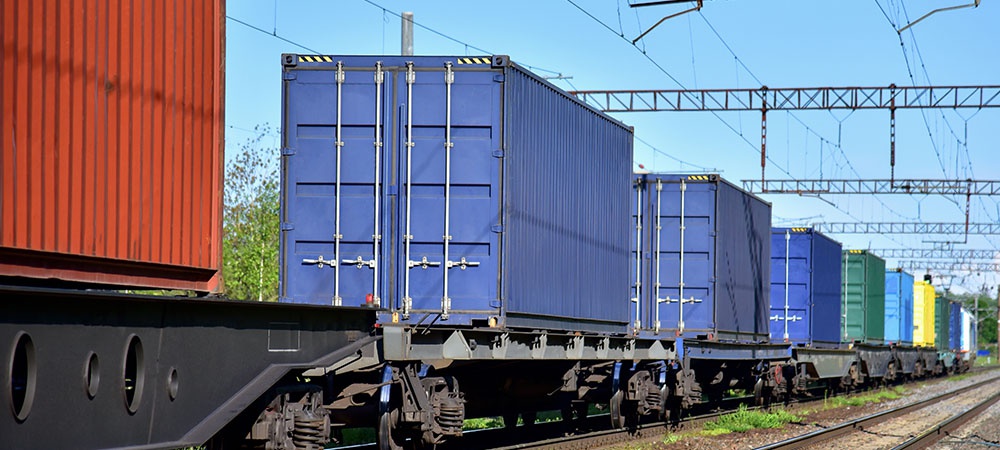Freight transportation is an integral part of modern business especially in our increasingly global economy. There are multiple ways to ship including by plane, train, truck, and boat. Generally speaking, freight transport by train is the cheapest when shipping over land while shipping by boat is cheapest when shipping across ocean waters.
However, you may need to use a combination of shipping methods in order to get your items where they need to be, when you need them to be there. In some cases the cheapest and most efficient option is to combine both truck and train shipping. In particular, this is necessary when transporting over great distances.
Additionally, the type of items you are shipping may require a shipping method that is not the cheapest but is the fastest, most secure, or safest. Here we will look at the cheapest and most effective way to transport freight based on the type of cargo, distance the cargo needs to travel, and other important factors along with pros and cons of each mode.
What is Freight?
Before jumping into modes of transport it is important to understand what is meant by “freight.” Freight is a shipment that is at least 150 lbs. Depending on the mode of transportation there will also be an upper limit of what is allowed in a single shipment. For example, shipping an FTL (full truckload) has a maximum allowable weight of 80,000 pounds. Special permits are needed if a shipment is heavier than this.
For shipments less than 150 lbs, a carrier such as United Parcel Service (UPS) is often the most logical and cost-effective option. When you send a smaller shipment like this, you will be able to decide between shipping speed options like next day vs 3-day select. The carrier will determine all other logistics in order to fulfill the request.
Parcel shipping of smaller items also differs from freight shipping in these ways:
- Freight shipping provides an estimated arrival while parcel delivery is usually an exact date.
- Freight shipping requires a full and accurate disclosure of what is being shipped while parcel shipping is less specific.
- In parcel shipping, lighter packages always ship for less than heavier. With freight, the dimensions and durability are factored into the cost versus just the weight alone.
What Affects the Cost of Freight Shipping?
No matter the mode of shipping, there are several factors that will affect the cost including:
- Weight and Density: Freight rates are calculated based on both weight and density since the amount of space an item takes up is as important as how much it weighs.
- Distance and Accessibility: Longer travel distances will mean greater cost but location is also a factor. If a location is hard to access or is very remote, costs will be higher.
- Shipping Speed: Expedited and express shipping options will be more expensive than slower shipping methods.
- Stability of Items: Items that are fragile or awkwardly shaped are more difficult to handle and more likely to be damaged. Due to this added risk, additional costs will apply.
- Environmental Factors: Certain times of year will be more difficult to ship during and will be more expensive. For example, winter weather will often cause delays. During the summer, perishable foods will also be more expensive to ship since they will require refrigeration and/or a faster shipping method.
Importance of Freight Class
Some of the factors above will be used to determine your shipment’s freight class. Freight class is a standardized pricing classification used in the shipping industry to create consistency across different brokers, carriers, and warehouses.
Factors that are used to determine freight class include dimensions, weight, value of items, density, liability, and ease of handling. Dense, durable items that can fit on a 4X4 pallet are a “50” freight class and will have the lowest per kilogram price. On the opposite end of the spectrum, less dense items like ping pong balls or paper coffee filters will have some of the highest per pound rates.
Choosing Cost-Effective Shipping Methods
There are four categories of freight transportation: ocean, rail, air, and ground shipping. Each has advantages and disadvantages. When basing a decision exclusively on price, train transport will typically be the cheapest when shipping within a country’s borders. Freight transport by boat is the cheapest for international shipping. However, there are other factors to consider.
Rail Shipping: Train shipping’s lower per pound rates make it ideal for very large, heavy items such as lumber. However, shipping by train is considerably slower than shipping by truck. Additionally, trains are not as flexible in terms of where they can deliver to since they can only go where rails will allow them.
Ground/Truck Shipping: Ground shipping offers the greatest flexibility since there are few limitations on where a truck can travel over land. This also helps shippers avoid the hassles associated with unloading items from planes or boats. Once unloaded, these items often will still need to be loaded onto a truck to make it to their final destination anyway.
However, ground shipping is not without its drawbacks especially if you are shipping a less than truckload (LTL). If your shipment does not fill the entire truck, it is likely that several stops will be made for other shipments which will slow shipping times. Additionally, because of the multiple stops this creates more chances for delays and damage to occur.
Air Shipping: Air shipping, offers the fastest but also most expensive shipping option. It is the best solution for when you need something delivered as fast as possible but is typically the worst option if cost is your main concern. In fact, shipping can be upwards of three times more expensive by air vs by ocean. That being said, air shipping is clearly not without its uses. It is often the only option for perishable goods when traveling over a great distance.
Ocean Shipping: Ocean shipping offers the exact opposite of air shipping: the cheapest method of shipping with the slowest delivery times. Though it can take several weeks for ocean delivery, it is the best option for cost-effective international shipping and is around a third of the cost of air shipping.
Combining Shipping Methods: In some situations two shipping methods will be used for a shipment. Primarily, a truck and/or a local delivery service will get items to their final destination since planes, trains, and boats do not have the flexibility required.
Get a Quote on the Cheapest Way to Transport Freight
With so many options and variables, Ontario Container Transport is here to help you navigate your shipping options. Our experienced team and trusted carrier network will assist you in finding the best, most cost-effective shipping solutions to meet your needs. Get started with a free quote on freight services today by calling (905) 695-1501.







